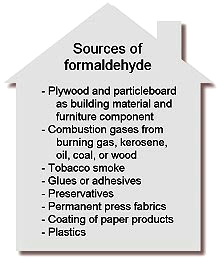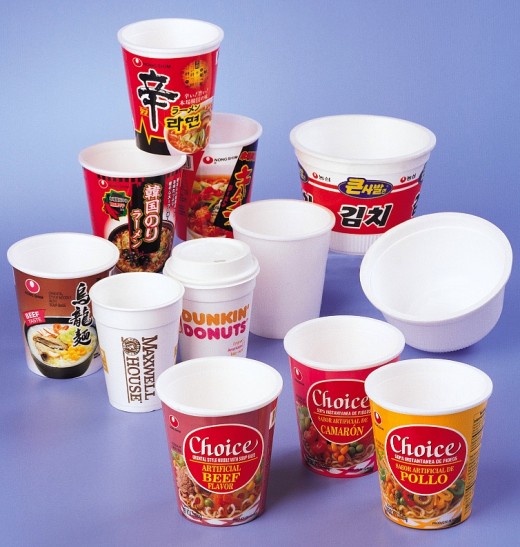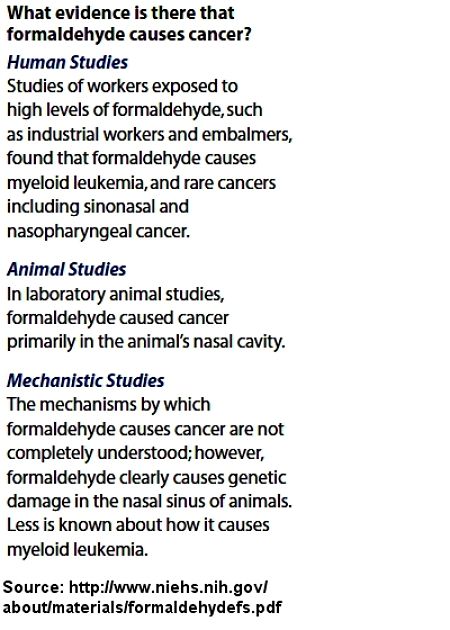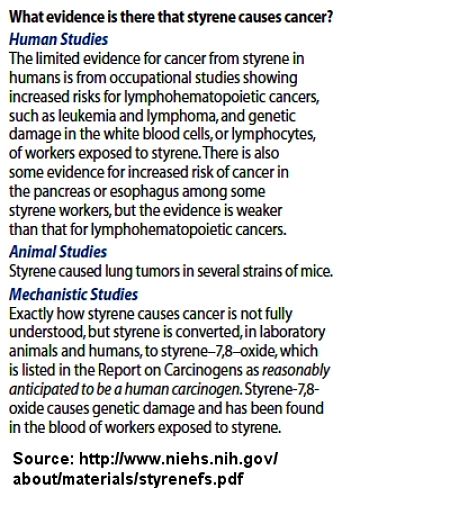Cancer Causing Agents - New Warnings Issued for Styrene, Formaldehyde
In a surprise move, two very common and widespread chemicals used in the building, food and packaging industries have been listed as potential carcinogens. The US Government added Formaldehyde and Styrene to the latest report after claimed delays caused by the manufacturers, because these chemicals are so widely used.
The warnings are part of the 12th Report on Carcinogens released on June 10, 2011, which is a science-based, congressionally mandated, public health document produced by the National Toxicology Program. The report identifies substances, agents, various mixtures, and exposure scenarios that research has shown are known to cause cancer in humans, or are reasonably anticipated to cause cancer. Below is a summary of the information - readers should consult the primary source for details including the two Fact Sheets for these chemicals.




Formaldehyde is a widely used as an ingredient in glues and is common in particle boards, plywood, pressboard, furniture, cabinets and kitchen cupboards and many other building materials. It is also used in some hair straightening and smoothing products and cigarette smoke. It can be released in car exhaust fumes and smoke from the burning of timer and other products. Factory workers are particularly at risk. Formaldehyde had been also been used as a laboratory preservative as formalin.
Styrene (polystrene) is found in foam coffee cups, food containers, various packaging materials, insulation and in many other building materials. It is widely used to make rubber and plastic goods. Factory workers are particularly at risk. It is also found in tobacco smoke.
Styrene is used to make polystyrene that is used for disposable cups, food containers, plastic packaging, building insulation. It is very widely used to make a variety of common products such as food containers, pipes, insulation, printing cartridges, automobile parts, and carpet backing. It is also an important component of fiberglass widely used in boats, carpet backing and shower stalls.
Much of the research that triggered these warnings comes from industrial and manufacturing environments where most of the risk or exposure occurs. The quantity of styrene in a coffee cup is tiny. Similarly there are only small traces of formaldehyde in the glues used to make particle board slabs and in the air in rooms of new buildings.
However health authorities have urged caution particularly for pregnant women and small children, who should consider avoiding the use polystyrene containers and other products that use styrene.
FACTS ON FORMALDEHYDE
How are people exposed to formaldehyde?
Highest exposure occurs in the workplace. The general population is exposed by breathing contaminated air and from tobacco smoke. Smoke from combustion sources, such as refineries, factories, forest fires, woodstoves, incinerators. Fumes may also be released from new buildings and renovations such as kitchen cupboards, or from home-finishing products. Other consumer goods, including hair products, cleaning agents, glues, and adhesives, may contain formaldehyde. Formaldehyde levels can be higher in the air inside buildings than in the air outside. © janderson99

How to prevent exposure to formaldehyde?
Choose pressed wood products that are free of formaldehyde or have greatly reduced levels . Check with the manufacturers about how to obtain these products. Increase ventilation, particularly after bringing new sources of formaldehyde into the home. Use fans and open windows to bring fresh air into the room until the risk subsides.
FACTS ON STYRENE
How are people exposed to Styrene?
Expose to styrene mostly occurs in the factories where the products are made. However people may be exposed to the vapors in the general environment and the home. You can be exposed to styrene through breathing styrene vapors derived from food containers, disposable coffee cups, building materials, photocopiers, tobacco smoke, and other products. Styrene may also leach from polystyrene food containers and storage boxes, but levels of styrene released are very low.

How can I prevent exposure to Styrene?
Stop smoking and limit children’s exposure to tobacco smoke. Employers and workers should apply appropriate occupational health standards and behaviors. This may include wearing respirators, protective clothing and gloves. Work places should be well ventilated. The general population may consider reducing their use of styrene containing packaging and containers.